Attached files
| file | filename |
|---|---|
| 8-K - FORM 8-K - STATE STREET CORP | d8k.htm |
 1
Well Positioned for the Future
Joseph L. Hooley
Chief Executive Officer
Edward J. Resch
Chief Financial Officer
INVESTOR AND ANALYST FORUM
5 May 2010
Exhibit 99.1 |
 2
Reminder
This
presentation
contains
forward-looking
statements
as
defined
by
United
States
securities
laws,
including
statements
about
our
goals
and
expectations
regarding
our
business,
financial
condition,
results
of
operations
and
strategies,
the
financial
and
market
outlook,
governmental
and
regulatory
initiatives
and
developments,
and
the
business
environment.
Forward-looking
statements
are
often
identified
by
such
forward-looking
terminology
as
"plan,"
"expect,"
"look,"
"believe,"
"anticipate,"
"estimate,"
"seek,"
"may,"
"will,"
"trend,"
"target,”
“scenario,”
and
"goal,"
or
similar
statements
or
variations
of
such
terms.
These
statements
are
not
guarantees
of
future
performance,
are
inherently
uncertain,
are
based
on
current
assumptions
that
are
difficult
to
predict
and
involve
a
number
of
risks
and
uncertainties.
Therefore,
actual
outcomes
and
results
may
differ
materially
from
what
is
expressed
in
those
statements,
and
those
statements
should
not
be
relied
upon
as
representing
our
expectations
or
beliefs
as
of
any
date
subsequent
to
May
5,
2010.
Important
factors
that
may
affect
future
results
and
outcomes
include,
but
are
not
limited
to:
financial
market
disruptions
and
the
economic
recession,
whether
in
the
U.S.
or
internationally,
and
monetary
and
other
governmental
actions,
including
regulation,
taxes
and
fees,
designed
to
address
or
otherwise
be
responsive
to
such
disruptions
and
recession,
including
actions
taken
in
the
U.S.
and
internationally
to
address
the
financial
and
economic
disruptions
that
began
in
2007;
increases
in
the
volatility
of,
or
declines
in
the
levels
of,
our
net
interest
revenue
or
other
revenue
influenced
by
market
factors,
changes
in
the
composition
of
the
assets
on
our
consolidated
balance
sheet
and
the
possibility
that
we
may
be
required
to
change
the
manner
in
which
we
fund
those
assets;
the
financial
strength
and
continuing
viability
of
the
counterparties
with
which
we
or
our
customers
do
business
and
to
which
we
have
investment,
credit
or
financial
exposure;
the
liquidity
of
the
U.S.
and
international
securities
markets,
particularly
the
markets
for
fixed-income
securities,
and
the
liquidity
requirements
of
our
customers;
the
credit
quality,
credit
agency
ratings,
and
fair
values
of
the
securities
in
our
investment
securities
portfolio,
a
deterioration
or
downgrade
of
which
could
lead
to
other-than-temporary
impairment
of
the
respective
securities
and
the
recognition
of
an
impairment
loss
in
our
consolidated
statement
of
income;
the
maintenance
of
credit
agency
ratings
for
our
debt
and
depository
obligations
as
well
as
the
level
of
credibility
of
credit
agency
ratings;
the
ability
to
complete
our
announced
and
pending
acquisitions,
as
well
as
future
acquisitions,
divestitures
and
joint
ventures,
including
the
ability
to
obtain
regulatory
approvals,
the
ability
to
arrange
financing
as
required,
and
the
ability
to
satisfy
other
closing
conditions;
the
risks
that
acquired
businesses
will
not
be
integrated
successfully,
or
that
the
integration
will
take
longer
than
anticipated,
that
expected
synergies
will
not
be
achieved
or
unexpected
disynergies
will
be
experienced,
that
customer
and
deposit
retention
goals
will
not
be
met,
that
other
regulatory
or
operational
challenges
will
be
experienced
and
that
disruptions
from
the
transaction
will
harm
relationships
with
customers,
employees
or
regulators;
the
possibility
of
our
customers
incurring
substantial
losses
in
investment
pools
where
we
act
as
agent,
and
the
possibility
of
further
general
reductions
in
the
valuation
of
assets;
our
ability
to
attract
deposits
and
other
low-cost,
short-term
funding;
potential
changes
to
the
competitive
environment,
including
changes
due
to
the
effects
of
consolidation
and
perceptions
of
State
Street
as
a
suitable
service
provider
or
counterparty;
the
level
and
volatility
of
interest
rates
and
the
performance
and
volatility
of
securities,
credit,
currency
and
other
markets
in
the
U.S.
and
internationally;
our
ability
to
measure
the
fair
value
of
the
investment
securities
on
our
consolidated
balance
sheet;
the
results
of
litigation,
government
investigations
and
similar
disputes
or
proceedings;
the
enactment
of
new
legislation
and
changes
in
governmental
regulation
and
enforcement
that
affect
us
or
our
customers,
and
which
may
increase
our
costs
and
expose
us
to
risk
related
to
compliance;
adverse
publicity
or
other
reputational
harm;
the
performance
and
demand
for
the
products
and
services
we
offer,
including
the
level
and
timing
of
withdrawals
from
our
collective
investment
products;
our
ability
to
grow
revenue,
attract
and/or
retain
and
compensate
highly
skilled
people,
control
expenses
and
attract
the
capital
necessary
to
achieve
our
business
goals
and
comply
with
regulatory
requirements;
our
ability
to
control
operating
risks,
information
technology
systems
risks
and
outsourcing
risks,
and
our
ability
to
protect
our
intellectual
property
rights,
the
possibility
of
errors
in
the
quantitative
models
we
use
to
manage
our
business
and
the
possibility
that
our
controls
will
fail
or
be
circumvented;
the
potential
for
new
products
and
services
to
impose
additional
costs
on
us
and
expose
us
to
increased
operational
risk;
changes
in
accounting
standards
and
practices;
and
changes
in
tax
legislation
and
in
the
interpretation
of
existing
tax
laws
by
U.S.
and
non-U.S.
tax
authorities
that
impact
the
amount
of
taxes
due.
Other
important
factors
that
could
cause
actual
results
to
differ
materially
from
those
indicated
by
any
forward-looking
statements
are
set
forth
in
our
2009
Annual
Report
on
Form
10-K,
and
our
subsequent
SEC
filings.
We
encourage
investors
to
read
these
filings,
particularly
the
sections
on
Risk
Factors,
for
additional
information
with
respect
to
any
forward-looking
statements
and
prior
to
making
any
investment
decision.
The
forward-looking
statements
contained
in
this
presentation
speak
only
as
of
the
date
hereof,
May
5,
2010,
and
we
do
not
undertake
efforts
to
revise
those
forward-looking
statements
to
reflect
events
after
that
date. |
 3
Well Positioned for the Future
Agenda
Key Trends
Competitive Positioning
Financial Review
Strategic Direction |
    4
Well Positioned for the Future
Agenda
Key Trends
Competitive Positioning
Financial Review
Strategic Direction |
 5
Worldwide Trends Support Our Strategy
Well Positioned for the Future
Key Trends
STRENGTH IN
CORE BUSINESSES
DRIVEN BY
•
Globalization
•
Retirement / Savings
•
Outsourcing
•
Consolidation
•
Increased Regulatory Oversight / Reform |
 6
Well Positioned for the Future
Key Trends —
Globalization
1
Total assets include seven key European markets: UK, Netherlands, Germany,
Ireland/Luxembourg offshore assets, Italy, Switzerland and France. 2
ICI, 9/09
3
For Germany , France, UK, Netherlands, Switzerland, Towers Watson, 12/09; for
Italy, OECD data as of 12/08, applied 8.8% growth rate (Allianz International
Pensions Studies Western
4
CEA
European
Insurance,
applied
8%
growth
rate
(STT
estimate)
to
2008
figures
Insurance assets: Applied 8% growth rate to 2008 figures, to be updated
5
Source: BCG, 4/10
UK
Netherlands
Germany
Offshore
(Ireland/Lux.)
Italy
Switzerland
France
Pensions:
$4.0T
Insurance:
$8.3T
Collectives:
$6.5T
European
Collective,
Pension,
Insurance
markets:
$18.8
trillion
European Market Forecast to Grow 5.9% over next 3 years
5
11%
1%
5%
47%
4%
3%
29%
45%
25%
10%
2%
14%
4%
31%
6%
23%
8%
5%
27%
1
2
3
4 |
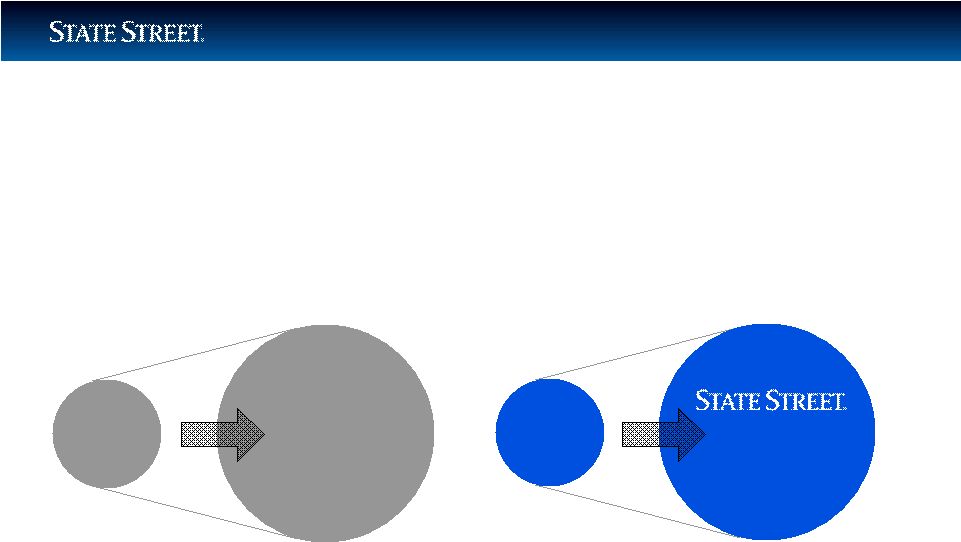     7
Well Positioned for the Future
Key Trends —
Globalization
$14.6T
2004
$18.8T
2009
$709.5B
2004
European Collective, Pension and
Insurance
Market
Growth
2004–2009
CAGR: 5.2%
State Street
European
AUC
Growth
2004–2009
CAGR: 21.4%
$1,867.9B
2009
1
2
1
Total assets include seven key European markets: UK, Netherlands, Germany, Ireland/Lux offshore
assets, Italy, Switzerland and France. Sources: ICI( 9/09), CEA 12/08), Watson Wyatt (12/09),
and State Street estimates. 2
AUC represents all European assets under custody. |
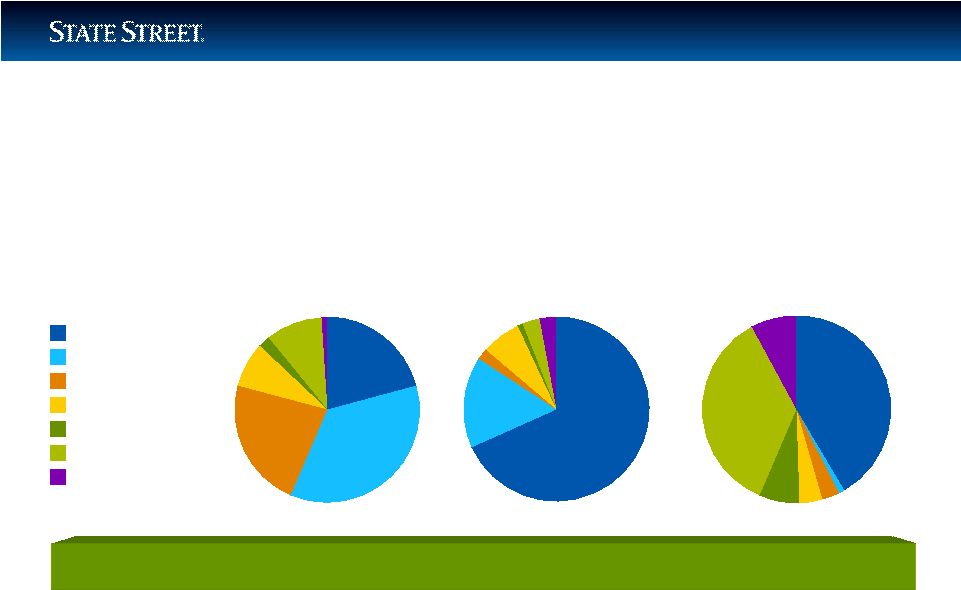 8
21%
35%
23%
8%
2%
10%
1%
Well Positioned for the Future
Key Trends —
Globalization
Asia-Pacific Collective, Pension and
Government-related
Markets:
$15.1
trillion
Pensions: $4.5T
Government
Related:
$7.4T
Collectives:
$3.2T
Japan
Australia
Hong Kong
South Korea
Taiwan
China
Singapore
68%
16%
2%
7%
1%
3%
3%
41%
1%
3%
4%
7%
36%
8%
Asia-Pacific Market Forecast to Grow 9.4% over next 3 years
4
2
3
1
1
Total assets include seven key markets: Japan, Australia, Hong Kong, South Korea, Taiwan, China
and Singapore. 2
Collectives as of September 2009
3
Government related: Japan includes Japan Post; Taiwan includes Chunghwa Post, formerly Taiwan Post
4
Source: BCG, 4/10
Sources: ICI (9/09), IMF (12/09), Cerulli Associates (12/08), Watson Wyatt (12/09), Monetary Authority
of Singapore MAS Survey, Singapore Central Provident Fund Board (12/08), Temasek Holdings,
HKSFC's Fund Management Activities Survey (12/08), Rainmaker (12/09), Korea National Pension Service, Korea Teacher Pension Fund; The
Bank of Korea, Korea Government Employee Pension Service (12/08); China National Council for Social
Security Fund (12/09), Central Bank of Republic of China (Taiwan) (9/09), Japan Post Bank
(12/09); State Street estimates |
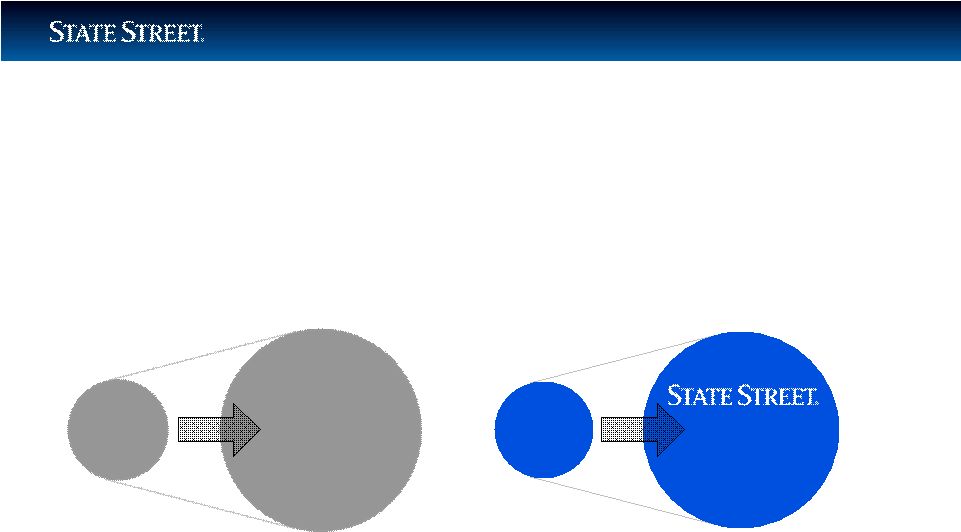     9
Well Positioned for the Future
Key Trends —
Globalization
$8.8T
2004
$15.1T
2009
$294.4B
2004
Asia-Pacific Collective, Pension
and Government
Market
Growth
2004–2009
CAGR: 11.4%
State Street
Asia/Pacific
AUC
Growth 2004–2009
CAGR: 17.1%
$648.1B
2009
1
2
1
Total assets include seven key markets: Japan, Australia, Hong Kong, South Korea, Taiwan, China and
Singapore. Sources: ICI (9/09), IMF (12/09), Cerulli Associates (12/08), Watson Wyatt (12/09), Monetary Authority
of Singapore MAS Survey, Singapore Central Provident Fund Board (12/08), Temasek Holdings,
HKSFC's Fund Management Activities Survey (12/08), Rainmaker (12/09), Korea National Pension Service, Korea Teacher Pension Fund; The
Bank of Korea, Korea Government Employee Pension Service (12/08); China National Council for Social
Security Fund (12/09), Central Bank of Republic of China (Taiwan) (9/09), Japan Post Bank
(12/09); State Street estimates 2
AUC represents all Asia/Pacific assets under custody. |
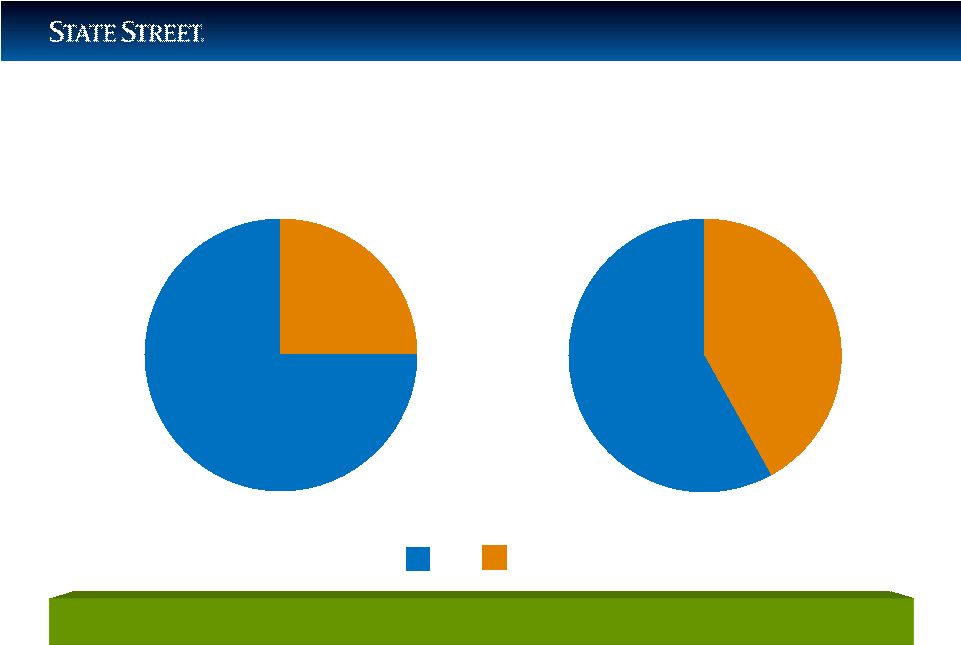 10
Well Positioned for the Future
Key Trends —
Globalization at State Street
Expect to Double Non-US Revenue over 5 Years
2
23%
77%
41%
59%
Revenue
1999
Pro Forma
2009
US
Non-US
1
1
Excludes impact of discount accretion ($621 million); reported 2009 non-US revenue for State
Street was $2.878 billion (36%); pro forma 2009 is adjusted for estimated impact of
ISPSS and Mourant
2
Assumes F/X rates stay constant. |
 11
Well Positioned for the Future
Key Trends —
Globalization at State Street
1
39% of State Street’s employees worked outside of the US as of December
31, 2009; pro forma 2009 is adjusted for 1,425 employees from ISPSS and Mourant.
State Street has Strong Presence in Non-US Locations
Employees
12%
88%
44%
56%
1999
Pro
Forma
2009
US
Non-US
1 |
 12
Well Positioned for the Future
Key Trends —
Retirement Savings
•
DC Plans are a Growing Segment for US Retirement Savings
US Defined Contribution Assets include 401(K), 403(b) and 457 plans; Source ICI, as
of 9/30/09. 0
1,000
2,000
3,000
4,000
5,000
'99
'00
'01
'02
'03
'04
'05
'06
'07
'08
'09
CAGR
’02–’07
’08 vs. ‘09
12%
15%
US Defined Contribution Assets
$M USD |
 13
Well Positioned for the Future
Key Trends —
Outsourcing
1
Pension & Investment,/Watson Wyatt World 500, 12/28/09.
2
As of 4/01/10
3
Preqin, 6/09
4
Hedge Fund Research, 3/31/10
5
McKinsey, 7/09
INVESTMENT MANAGER
OPERATIONS
OUTSOURCING
•
State Street is leading provider with more than $7 trillion of AUA in
this market that is sized at approximately $53 trillion
PRIVATE EQUITY
ADMINISTRATION
•
With the Mourant
acquisition, State Street is the largest servicer of
private equity in the world with $255 billion of AUA
in a market
sized at $2.3 trillion
HEDGE FUND
SERVICING
•
State Street services more than $300 billion of AUA in hedge fund
assets —
the second largest servicer in the world in a $1.7 trillion
market
4
growing
at
an
estimated
19%
CAGR
over
the
next
4
years
5
FUND ACCOUNTING
AND ADMINISTRATION
•
Market-leading position
•
Integrated, global, multi-currency system
1
3
2 |
 14
Well Positioned for the Future
Key Trends —
Outsourcing
INVESTMENT
MANAGEMENT
SOLUTIONS
•
Customized strategic and tactical asset allocation solutions
through flexible and efficient portfolio implementation across and
within global asset classes
TRANSITION
MANAGEMENT
•
Provide transparent, efficient transitions and allocation
management for pension plans; managed transitions with total
assets of $173 billion in 1,006 transitions in 2009
ELECTRONIC
TRADING
•
Continued growth expected
•
Acquired Currenex, a fast-paced, high-speed trading solution to
compliment FX Connect |
 15
Well Positioned for the Future
Key Trends —
Consolidation
11
of
the
Top
20
Custodians
Each
Have
Less
Than
$3
Trillion
in
Assets
1
GlobalCustody.net, adjusted for acquisition of ISPSS and BHF.
FACTORS
•
Global footprint and scale essential
•
Ongoing need for investment in technology
•
Competing demands for capital
•
Distribution: Access to global clients
Industry Will Consolidate With Major Providers
1 |
 16
Well Positioned for the Future
Key Trends —
Consolidation
DEUTSCHE BANK’S GSS
Established State Street’s leadership position in Europe
IFS
Added hedge fund servicing capability
CURRENEX
Expanded electronic high-speed trading capability
PALMERI
Accelerated State Street’s leadership in private equity servicing
INVESTORS FINANCIAL
Expanded share of mutual fund and hedge fund servicing markets
Excellent Track Record in Executing Accretive Acquisitions
|
 17
Well Positioned for the Future
Key Trends —
Consolidation
INTESA SANPAOLO’S
SECURITIES
SERVICES
1
•
Enhances European servicing capability
•
Acquiring
custody, fund administration, depository bank
and banca
corrispondente
•
Paying
€1.28B
2
in
cash
•
Goal to retain 90% of revenue of ~€293M
•
~€343
in
custody
assets
3
•
~€11B in cash deposits
4
•
Removing ~€60M in costs over 5 years
•
Incurring ~€80M (pre-tax) in merger and integrations costs
•
Expect to be modestly accretive (excluding M & I costs)
•
Will have capital ratios at closing approximately at the
levels as of 9/30/09
1
Expected to close in Q2 2010 subject to regulatory approvals and other closing conditions.
2
State Street expects to support the acquired ISPSS balance sheet with approximately €560
million of additional capital at the closing. 3
Average for first half of 2009.
4
At 6/30/09. |
 18
Well Positioned for the Future
Key Trends —
Consolidation
MOURANT
INTERNATIONAL
FINANCE
ADMINISTRATION
•
State
Street
is
now
1
:
–
No.1 in alternative asset servicing globally
–
No.1 in private equity servicing globally
–
No.1 in real estate asset servicing globally
–
No. 2 in hedge fund servicing globally
•
Cash purchase
•
Annualized revenue of about $100 million
•
Mostly non-US assets
•
Provides cross-sell opportunities
•
Expected to be slightly accretive in 2010 (excluding M & I costs)
1
Incorporating Mourant data with data from HFM Week, April 2009; ICFA Alternative Fund Administration
Survey, April/May 2009 |
    19
Well Positioned for the Future
Agenda
Key Trends
Competitive Positioning
Financial Review
Strategic Direction |
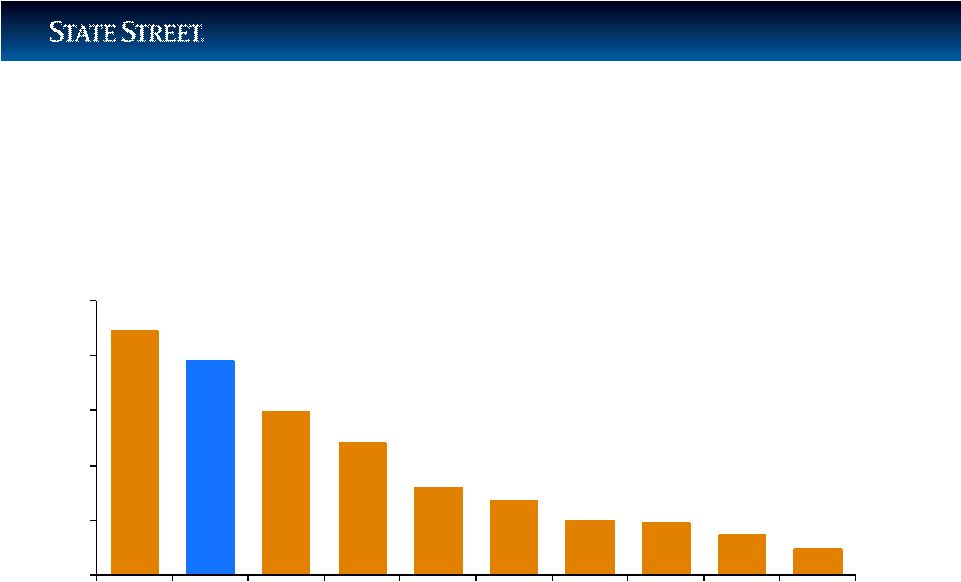 20
(USD $T)
1
Source: Global Custody.net, 12/31/2009
2
Includes assets of approximately $670 billion in assets from ISPSS and
Mourant 3
AUC Only
Source: Company filings, as of 12/31/09; globalcustody.net
Well Positioned for the Future
Competitive Positioning —
Assets Under Custody/Administration
22.3
19.5
14.9
12.1
8.0
6.8
5.0
4.8
3.7
2.4
$0
$5
$10
$15
$20
$25
BK
STT
JPM
Citi
HSBC
BNP
Soc Gen
CACEIS
NTRS
RBCD
3
3
3
Total
Worldwide
Custody
Assets:
$104
trillion
1
2 |
 21
1
Data also includes UIT Accounting.
Source: The NASDAQ Stock Market Inc., Data Products, as of 2/1/10
Well Positioned for the Future
Competitive
Positioning
—
US
Mutual
Funds
Number of Funds Priced Daily
0
2,000
4,000
6,000
8,000
10,000
STT
BK
PFPC
JPM
First Trust
Citi
Fidelity
US Bancorp
Van Kampen
Princor
41%
6%
5%
5%
4%
4%
4%
3%
2%
2%
1 |
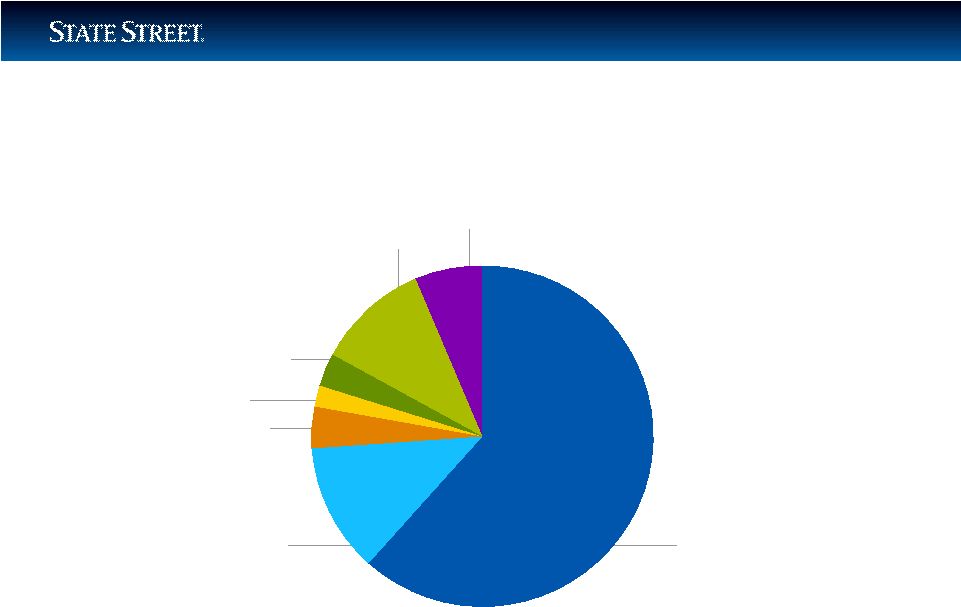 22
Well Positioned for the Future
Competitive Positioning —
Investment Manager Operations Outsourcing
STT
62%
BK
12%
JPM
4%
HSBC
2%
NTRS
3%
RBCD
11%
BBH
6%
Source: Scrip Issue Global Report, (3/10) |
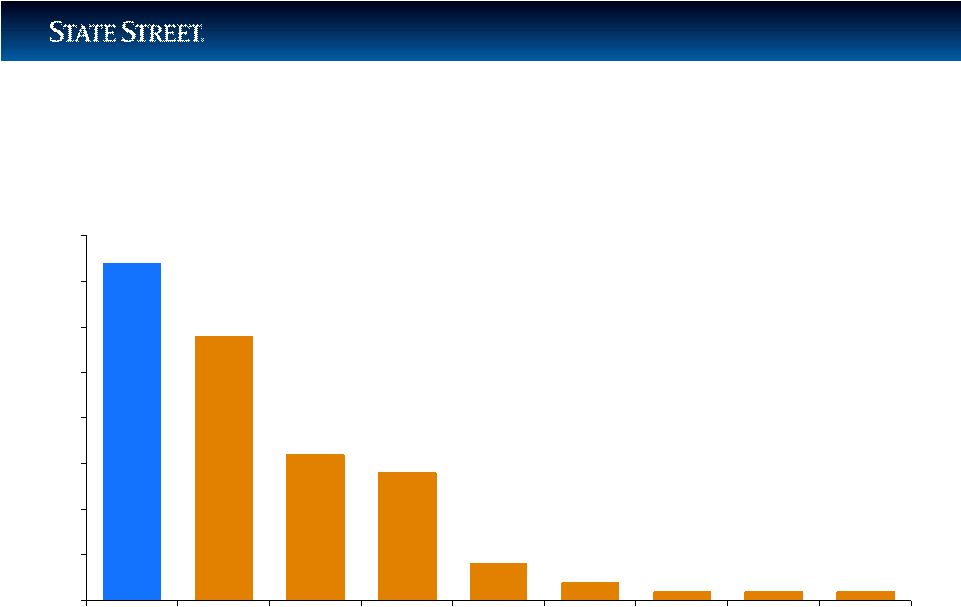 23
3.7
2.9
1.6
1.4
0.4
0.2
0.1
0.1
0.1
0.0
0.5
1.0
1.5
2.0
2.5
3.0
3.5
4.0
STT
BNY
NTRS
JPM
RBCD
Citi
SocGen
HSBC
BBH
(USD $T)
Well Positioned for the Future
Competitive
Positioning
—
Pension
Fund
Assets
1
Data is self reported to Scrip Issue Global Report (3/10)
1 |
 24
Well Positioned for the Future
Competitive Positioning —
Alternative Assets Under Administration
USD $B
$0
$100
$200
$300
$400
$500
$600
STT
Citco
Citi
HSBC
BK
Fortis
SEI
GS
UBS
JPM
Real Estate
Private Equity Assets
Hedge Fund Assets
596
491
329
283
217
182
168
164
159
151
Sources: HFM Week 13th Biannual Assets Under Administration
Survey, November 2009; STT AUA as of 12/31/09, adjusted for Mourant; ICFA Alternative Fund Administration
Survey April/May 2009; 2009 Global Custodian Private Equity Fund Administrators Survey; Prequin
12/31/08. |
 25
Well Positioned for the Future
Competitive
Positioning
—
US
ETF
Assets
Under
Management
373
189
92
46
24
12
9
8
6
6
$0
$50
$100
$150
$200
$250
$300
$350
$400
BLK
SSgA
Vanguard
Invesco
ProShares
Van Eck
BK
US Comm
Funds
Wisdom
Tree
Rydex
USD $B
Source: National Stock Exchange as of 12/31/09 |
 26
(USD $B)
345
253
206
152
122.
$0
$50
$100
$150
$200
$250
$300
$350
BLK
SSgA
Northern Trust
Vanguard
BNY Mellon
Source: Pensions & Investments as of December 31, 2008
Includes US Institutional, tax-exempt assets managed internally (assets managed
passively on behalf of non-US entities are not represented) Well Positioned
for the Future Competitive
Positioning
—
Top
Managers
of
US-Domiciled
Indexed
Equities
and Fixed Income |
 27
Well Positioned for the Future
Competitive
Positioning
—
Recent
Recognition
No. 1 Manager
of Worldwide
Institutional Assets
Pensions & Investments,
2009 Money Managers Survey
Custodian of the Year
2010 Global Pensions Awards
Top Rated in Pre-Trade,
Post-Trade, Organization
and Support
Plansponsor, 2009 Transition
Management Survey
No. 1 Global Custodian
for Clients with $10B+
in Assets
Global Custodian
2009 Global Custody Survey
No. 1 Global Mutual
Fund Administrator
Global Custodian
2009 Mutual Fund
Administration Survey
Most Recognized
ETF Brand
exchangetradedfunds.com
2009 Global ETF Awards
Global Private Equity Fund
Administrator of the Year
International Custody and
Fund Administration
2009
Global Awards
Global Securities Lender
of the Year
International Custody and
Fund Administration
2009
Global Awards
No. 1 in Flow Research
Euromoney
2009 FX Survey |
 28
Well Positioned for Growth
Competitive
Positioning
—
Strength
in
Winning
New
Business
•
$1.1 trillion in assets to be serviced won in 2009
•
In 2009 top 100 clients used 13.8 products
•
$319 billion in assets to be serviced won YTD (4/15/10)
•
Strong pipeline in both asset management and asset servicing
•
More than 200 of 300 of the largest investment managers
in the world are our clients
70% Win Ratio on Competitive Bids in 2009
1
As measured by Assets Under Management
1 |
 29
Well Positioned for the Future
Long-Term
Operating-Basis
Financial
Goals
Key Trends and Competitive Position Support Long-term Goals
1
For a description of operating-basis presentation, see Appendix.
Operating-basis EPS Growth of 10% –
15%
Operating-basis ROE of 14% –
17%
Operating-basis Revenue Growth of 8% –
12%
1 |
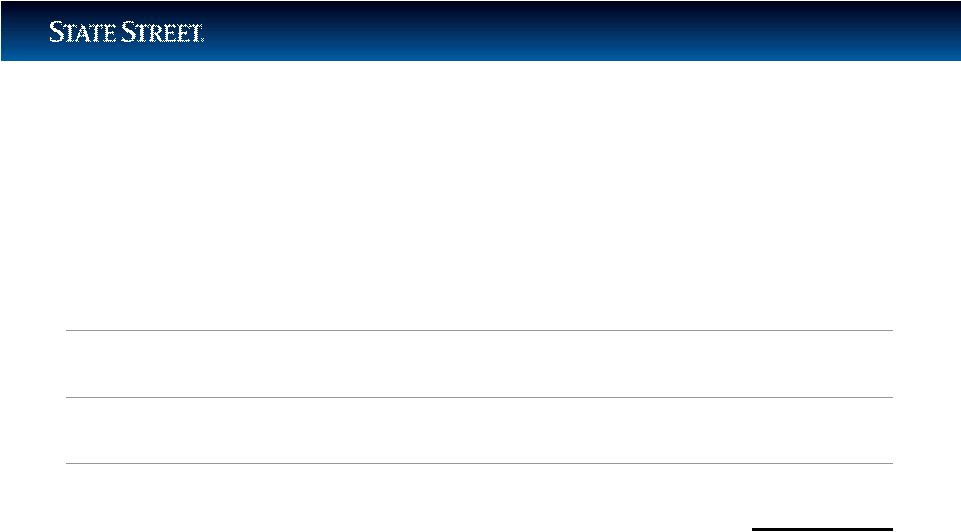 30
Well Positioned for the Future
Long-Term Financial Goals —
Operating-basis
Revenue
Growth
Model
1
For a description of operating-basis presentation, see Appendix.
2
Assumes 7% average annual growth in global equities.
Market growth
1% –
2%
New clients
2% –
3%
Additional sales to existing clients
4% –
5%
Acquisitions
1% –
2%
8% –
12%
1
2 |
 31
Edward J. Resch
Chief Financial Officer
FINANCIAL REVIEW |
 32
Well Positioned for the Future
Financial Review
Balance Sheet and Capital Position: A Strong Foundation
Market-driven Revenue: NIR/NIM, Securities Finance,
Foreign Exchange
Operating Performance in 2010: Growth in a
Challenging Environment |
   33
Well Positioned for the Future
Financial Review
Balance Sheet and Capital Position: A Strong Foundation
Market-driven Revenue: NIR/NIM, Securities Finance,
Foreign Exchange
Operating Performance in 2010: Growth in a
Challenging Environment |
 34
Well Positioned for the Future
Financial Review —
Balance Sheet and Capital Position:
A Strong Foundation
Currently Well Positioned
BALANCE
SHEET AS OF
3/31/10
•
Total Balance Sheet: $154 billion
–
“Normalized”
Balance Sheet: $135 billion
–
Duration gap: approximately 0.31 years
•
Investment Portfolio of $93 billion
–
Duration: approximately 1.27 years
–
Solid credit profile
–
Unrealized after-tax loss: $1.4 billion, down 77% from 12/31/08
•
Liabilities
–
Customer driven
–
Integral to custody relationship
•
Strong Capital Ratios |
 35
Well Positioned for the Future
Financial Review —
Balance Sheet and Capital Position:
A Strong Foundation
Maintaining Flexibility Pending Regulatory Guidance
1
For a description of the capital ratios, including certain related reconciliations,
please see Appendix. CAPITAL
MANAGEMENT
•
Successfully executed TCE improvement plan in 2009
•
Capital ratios are well in excess of regulatory requirements for
“well capitalized”
•
State Street’s target ratios
1
:
–
Leverage: 5.25% to 5.75%
–
TCE: 4.25% to 4.75%
•
Sources of capital
–
Net earnings
–
Equity from employee compensation programs
•
Uses of capital
–
Reinstating dividend a priority
–
Organic growth opportunities
–
Repurchase of shares |
 36
1
Except as noted in note 4 below, minimum “Well Capitalized”
as defined by Federal regulators.
2
Estimated including acquisition of ISPSS; earnings based on First Call analyst
consensus estimate and estimated impact on earnings of discount accretion.
3
Minimum “Well Capitalized,”
as defined by Federal regulators, applies to State Street Bank and Trust only.
4
Target ratio as defined by State Street.
5
Ratio as defined by Moody’s Investors Service, Inc.
For a description of the capital ratios, including certain related reconciliations,
please see Appendix. Well Positioned for the Future
Financial
Review
—
Balance
Sheet
and
Capital
Position:
A Strong Foundation
Strong Capital Generation and Strategic Deployment
“Well
State Street Corp.
Capitalized”
1
Q2 ’10 E
2
Q1 ’10
Q4 ’09
Tier 1 Leverage
5%
3
7.2%
9.0%
8.5%
Tier 1 Capital
6%
15.6%
18.1%
17.7%
Tier 1 Common Ratio
13.6%
15.9%
15.6%
Total Capital
10%
17.0%
19.5%
19.1%
Tangible Common Equity
4.25% –
4.75%
4
5.5%
7.5%
6.6%
TCE/RWA
5
11.7%
14.1%
12.8% |
   37
Well Positioned for the Future
Financial Review
Balance Sheet and Capital Position: A Strong Foundation
Market-driven Revenue: NIR/NIM, Securities Finance,
Foreign Exchange
Operating Performance in 2010: Solid Growth in a
Challenging Environment
•
2010 Scenarios for Net Interest Margin:
–
Flatter Curve
–
Most Likely
–
Higher Rates
•
A View of Structural NIM
•
Securities Finance
•
Foreign Exchange |
 38
Well Positioned for the Future
Financial Review —
Market-driven Revenue:
NIR/NIM, Securities Finance, Foreign Exchange
ASSUMPTIONS (INCLUDING ISPSS)
•
Balance sheet about $150 billion
•
Duration gap about 0.50 years
MOST LIKELY ECONOMIC SCENARIO
•
Slow, steady recovery
•
House price stabilization
•
Slow improvement in unemployment
•
S & P 500 at 1125 on average for the year
2010
SCENARIOS
FOR
NET
INTEREST
MARGIN
1
1
Excluding discount accretion and related tax-equivalent adjustments; for a
reconciliation to GAAP, see Appendix. 2
Federal Funds
Flatter
Curve
Most Likely
Higher
Rates
FF²
2010 (avg.)
0.25%
0.25%
0.60%
FF²
year-end
0.25%
0.25%
1.00%
Yield curve
Flattens
Steep
Steep
FF²
to 2-year (avg.)
0.50%
1.25%
1.20%
FF²
to 10-year (avg.)
2.75%
3.80%
3.75%
2010 NIM (in bps) (avg.)
140–150
150–160
150–160 |
 39
Well Positioned for the Future
Financial
Review
—
Market-driven
Revenue:
NIR/NIM, Securities Finance, Foreign Exchange
1
Excludes discount accretion
Yield in %
NIM in bps
Historical Trends in Yield Curve, FF Rate and STT’s
NIM
NIM ¹
Fed Funds
FF to 5-Year Treasury Spread |
 40
Well Positioned for the Future
Financial Review —
Market-driven Revenue:
NIR/NIM, Securities Finance, Foreign Exchange
MARKET FACTORS
•
Level of rates —
FF to 3%
•
Shape of the curve —
FF to 5-year
is 100-125 bps
•
Asset spreads —
Not to widen from
current level
•
Pace of rate change —
Measured pace
of increase
CONTROLLABLE FACTORS
•
Credit quality —
Continue AAA/AA focus
•
Interest –rate risk —
Approximate duration
of 0.5 years
•
Asset strategy —
Maintain current
investment strategy
•
Capital —
Maintain current capital level
OUTLOOK FOR NORMALIZED NET INTEREST MARGIN
Expect Normalized NIM to Settle in Range of 1.75% –
1.85%
1
Federal Funds
1
1 |
 41
Well Positioned for the Future
Financial Review —
Market-driven
Revenue:
NIR, Securities Finance,
Foreign Exchange REVENUE TRENDS IN SECURITIES FINANCE
1
Based on data from Data Explorers Universe as of period end.
REVENUE DRIVEN
BY COMBINATION
OF VOLUMES,
SPREAD, AND
DURATION OF
PORTFOLIO
VOLUMES
•
Assets on loan at about $400B for past 5 quarters with NYSE short
interest below historic levels
–
Believe volumes are at or near a trough for this cycle
•
Expect volumes to improve as economic recovery continues
•
From Q1 ’07 to Q1 ’10 our market share increased from 21% to more
than 28%
1
SPREAD
•
3-month LIBOR to FF spread widened (Q4 ’08) to unprecedented levels
and then tightened (Q1 ’10)
•
Expect modest improvement in spreads in 2H ’10
PORTFOLIO DURATION
•
Reduced to 21 days (Q1 ’10) from 35 days (Q1 ’07) as asset owners
sought higher levels of liquidity
•
Expect duration to increase as liquidity requirements lessen
|
 42
Well Positioned for the Future
Financial Review —
Market-driven
Revenue:
NIR, Securities Finance,
Foreign Exchange REVENUE TRENDS IN FOREIGN EXCHANGE
April Volumes Increased Above Q1 Monthly Average
1
STT’s
customer-weighted volatilities.
REVENUE DRIVEN
BY COMBINATION
OF VOLUMES AND
VOLATILITY
VOLUMES
•
Q1 ’10 volumes annualized ($2.9TN) tracking above 2009 level, but not at
level of 2007 and 2008 ($3.4 TN on avg.)
•
Expect increased cross-border flows to drive improvement in F/X
environment and volumes
VOLATILITY
•
Average annual volatility in ’08 and ’09
(1.36%
avg.)¹
significantly
above
level of Q1 ’10 (0.99%)¹
•
Expect Q1 ’10 level to be maintained or improved slightly as Central Banks
respond to levels of economic activity globally
|
   43
Well Positioned for the Future
Financial Review
•
Q1 2010 Performance
•
Core Business Strength
•
Expense Initiatives
Balance Sheet and Capital Position: A Strong Foundation
Market-driven Revenue: NIR/NIM, Securities Finance,
Foreign Exchange
Operating Performance in 2010: Growth in a
Challenging Environment |
 44
Continuing to Perform in Challenging Times
Well Positioned for the Future
Financial Review —
Operating Performance in 2010:
Growth in a Challenging Environment
Results¹
for 3 Months Ended
$ in millions, except per share data
3/31/10
12/31/09
% Change
Operating-basis revenue
$2,116
$2,082
1.6%
Operating-basis expenses
$1,566
$1,556
0.6%
Operating-basis EPS
$0.75
$0.71
5.6%
Operating-basis ROE
10.0%
9.9%
Positive operating leverage²
100 bps
1
Results presented on an operating basis, including fully taxable-equivalent
revenue; for a description of operating-basis presentation and related reconciliations, please see Appendix.
2
Positive operating leverage is defined as the excess rate of growth of total
revenue over the rate of growth of total expenses, each determined on an operating basis. |
 45
Well Positioned for the Future
Financial Review —
Operating Performance in
2010: Growth in a
Challenging Environment OPERATING
MODEL
IMPROVEMENT
•
Aggressively managing expenses in response to current
environment
•
Restructured workforce in 2009
•
Implementing LEAN (begun in 2009)
•
Utilizing operations in Poland, China and India
•
Advancing technology to decrease unit cost factors
•
Optimizing global real estate footprint |
    46
Well Positioned for the Future
Agenda
Key Trends
Competitive Positioning
Financial Review
Strategic Direction |
 47
Well Positioned for the Future
Strategic Direction
FOCUSED ON
•
Doubling non-US revenues over the next five years
•
Accelerating market share globally through organic growth
and acquisition
•
Driving industry innovation for clients by maintaining technology
investment at 20% –
25% of operating expenses
•
Strengthening industry-leading operating model
•
Achieving positive operating leverage on annual basis
•
Enhancing risk management capabilities across organization
|
 48
Well Positioned for the Future
Summary —
Expectations Fueling Confidence in 2010 Outlook
•
Strength in servicing fee revenue
•
Successful integration of acquisitions
•
Modest improvement in management fee revenue
•
NIM in range of 150–160 bps
•
Gradual improvement in F/X and Securities Finance in 2H
•
Expense control commitments
•
No further net securities gains, OTTI, or LLP budgeted
Expect Operating-Basis EPS to be Slightly Above 2009 Level of $3.32
|
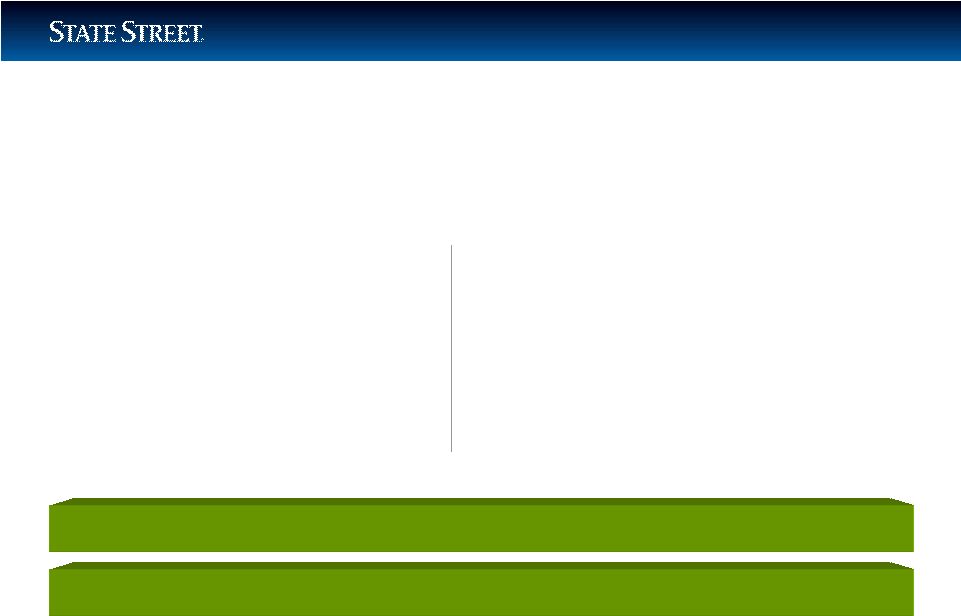 49
Well Positioned for the Future
Summary
•
Well positioned against global
growth trends
•
Excellent competitive position
•
Worldwide client relationships
•
Strong capital position
Committed to Delivering Shareholder Value
Committed to Long-Term Financial Goals
•
Expanding core business
•
Proven track record integrating
acquisitions
•
Talented global employee base
•
Disciplined expense management |
 50 |
STATE STREET CORPORATION
TANGIBLE COMMON EQUITY AND TIER 1 COMMON RATIOS
As of Period End
The ratio of tangible common equity to adjusted tangible assets, or TCE ratio, is calculated by dividing consolidated total common shareholders’ equity by consolidated total assets, after reducing both amounts by goodwill and other intangible assets net of related deferred taxes. Total assets reflected in the TCE ratio also exclude cash balances on deposit at the Federal Reserve Bank and other central banks in excess of required reserves. The TCE ratio is not required by GAAP or by bank regulations, but is a metric used by management to evaluate the adequacy of State Street’s capital levels. Since there is no authoritative requirement to calculate the TCE ratio, our TCE ratio is not necessarily comparable to similar capital measures disclosed or used by other companies in the financial services industry. Tangible common equity and adjusted tangible assets are non-GAAP financial measures and should be considered in addition to, not as a substitute for or superior to, financial measures determined in accordance with GAAP.
The tier 1 risk-based common, or tier 1 common, ratio is calculated by dividing tier 1 capital less non-common elements, including qualifying trust preferred securities, by total risk-weighted assets, which assets are calculated in accordance with applicable bank regulatory requirements. The tier 1 common ratio is not required by GAAP or on a recurring basis by bank regulations. However, this ratio was used by the Federal Reserve in connection with its stress test administered to the 19 largest U.S. bank holding companies under the Supervisory Capital Assessment Program, the results of which were announced in May 2009. Although we understand that the Federal Reserve does not intend to prospectively require calculation of the tier 1 common ratio, due to the recent timing of the Supervisory Capital Assessment Program, management is currently monitoring this ratio, along with the other capital ratios, in evaluating State Street’s capital levels and believes that, at this time, the ratio may be of interest to investors.
The table set forth below presents the calculations of State Street's ratios of tangible common equity to total tangible assets and tier 1 common capital to total risk-weighted assets.
| (Dollars in millions) |
March 31, 2010 |
December 31, 2009 |
September 30, 2009 |
|||||||||||
| Consolidated Total Assets |
$ | 153,971 | $ | 157,946 | $ | 163,277 | ||||||||
| Less: |
||||||||||||||
| Goodwill |
4,515 | 4,550 | 4,554 | |||||||||||
| Other intangible assets |
1,768 | 1,810 | 1,845 | |||||||||||
| Excess reserves held at central banks |
19,235 | 21,731 | 22,125 | |||||||||||
| Adjusted assets |
128,453 | 129,855 | 134,753 | |||||||||||
| Plus: |
||||||||||||||
| Deferred tax liability |
515 | 521 | 524 | |||||||||||
| Total tangible assets |
A | $ | 128,968 | $ | 130,376 | $ | 135,277 | |||||||
| Consolidated Total Common Shareholders' Equity |
$ | 15,410 | $ | 14,491 | $ | 13,440 | ||||||||
| Less: |
||||||||||||||
| Goodwill |
4,515 | 4,550 | 4,554 | |||||||||||
| Intangible assets |
1,768 | 1,810 | 1,845 | |||||||||||
| Adjusted equity |
9,127 | 8,131 | 7,041 | |||||||||||
| Plus deferred tax liability |
515 | 521 | 524 | |||||||||||
| Total tangible common equity |
B | $ | 9,642 | $ | 8,652 | $ | 7,565 | |||||||
| Tangible common equity ratio |
B/A | 7.5 | % | 6.6 | % | 5.6 | % | |||||||
| Ratio of tangible common equity to total risk-weighted assets |
B/D | 14.1 | % | 12.8 | % | 10.2 | % | |||||||
| Tier 1 capital |
$ | 12,335 | $ | 12,005 | $ | 11,271 | ||||||||
| Less trust preferred securities |
1,450 | 1,450 | 1,450 | |||||||||||
| Tier 1 common capital |
C | $ | 10,885 | $ | 10,555 | $ | 9,821 | |||||||
| Total risk-weighted assets |
D | 68,247 | 67,691 | 73,823 | ||||||||||
| Ratio of tier 1 common capital to total risk-weighted assets |
C/D | 15.9 | % | 15.6 | % | 13.3 | % | |||||||
STATE STREET CORPORATION
RECONCILIATION OF REPORTED RESULTS TO OPERATING-BASIS RESULTS
We measure and compare certain financial information on a non-GAAP, or “operating” basis because we believe that such information supports meaningful comparisons from period to period and the analysis of comparable financial trends with respect to our normal ongoing business operations. We believe that operating-basis financial information, which reports revenue from non-taxable sources on a fully taxable-equivalent basis and excludes the impact of revenue and expenses outside of the normal course of our business, facilitates an investor’s understanding and analysis of State Street’s underlying performance and trends in addition to reported financial information, which is prepared in accordance with GAAP. The following table reconciles financial information prepared in accordance with GAAP to operating-basis financial information.
| (Dollars in millions, except per share amounts) |
Quarter Ended December 31, 2009 | Quarter Ended March 31, 2010 | % Change | ||||||||||||||||||||||||
| Reported Results |
Adjustments | Operating Results |
Reported Results |
Adjustments | Operating Results |
Q4 2009 vs Q1 2010 |
|||||||||||||||||||||
| Total fee revenue |
$ | 1,526 | $ | 1,526 | $ | 1,540 | $ | 1,540 | 0.9 | ||||||||||||||||||
| Net interest revenue |
697 | $ | (198 | )(1) | 499 | 661 | $ | (180 | )(4) | 481 | (3.6 | ) | |||||||||||||||
| Gains related to investment securities, net |
57 | — | 57 | 95 | — | 95 | |||||||||||||||||||||
| Total revenue |
2,280 | (198 | ) | 2,082 | 2,296 | (180 | ) | 2,116 | 1.6 | ||||||||||||||||||
| Provision for loan losses |
35 | — | 35 | 15 | — | 15 | |||||||||||||||||||||
| Total expenses |
1,565 | (9 | )(2) | 1,556 | 1,579 | (13 | )(2) | 1,566 | 0.6 | ||||||||||||||||||
| Income before income tax expense |
680 | (189 | ) | 491 | 702 | (167 | ) | 535 | |||||||||||||||||||
| Income tax expense |
182 | (76 | )(3) | 106 | 207 | (75 | )(6) | 132 | |||||||||||||||||||
| Tax-equivalent adjustment |
— | 32 | (5) | 32 | — | 32 | (5) | 32 | |||||||||||||||||||
| Net income available to common shareholders |
$ | 498 | $ | (145 | ) | $ | 353 | $ | 495 | $ | (124 | ) | $ | 371 | 5.1 | ||||||||||||
| Diluted earnings per common share |
$ | 1.00 | $ | (.29 | ) | $ | .71 | $ | .99 | $ | (.24 | )$ | .75 | 5.6 | |||||||||||||
| Average diluted common shares outstanding (in thousands) |
497,615 | 497,615 | 497,615 | 498,056 | 498,056 | 498,056 | |||||||||||||||||||||
| Return on common equity |
14.0 | % | (4.1 | )% | 9.9 | % | 13.4 | % | (3.4 | )% | 10.0 | % | |||||||||||||||
| (1) | Represents tax-equivalent adjustment of $32 million, which is not included in reported results, net of $230 million of discount accretion for the period, related to a portion of the aggregate difference between the fair value and the par value of the asset-backed commercial paper conduits' investment securities on the date of consolidation of the conduits onto the balance sheet. |
| (2) | Represents merger and integration costs recorded in connection with acquisitions. |
| (3) | Represents $15 million of aggregate income tax benefit related to merger and integration costs and the provision for legal exposure associated with certain fixed-income strategies managed by SSgA, net of $91 million of income tax expense related to discount accretion. |
| (4) | Represents tax-equivalent adjustment of $32 million, which is not included in reported results, net of $212 million of discount accretion for the period, primarily related to a portion of the aggregate difference between the fair value and the par value of the asset-backed commercial paper conduits' investment securities on the date of consolidation of the conduits onto the balance sheet. |
| (5) | Represents tax-equivalent adjustment, which is not included in reported results. |
| (6) | Represents $8 million of income tax benefit related to the merger and integration costs net of $83 million of income tax expense related to discount accretion. |
